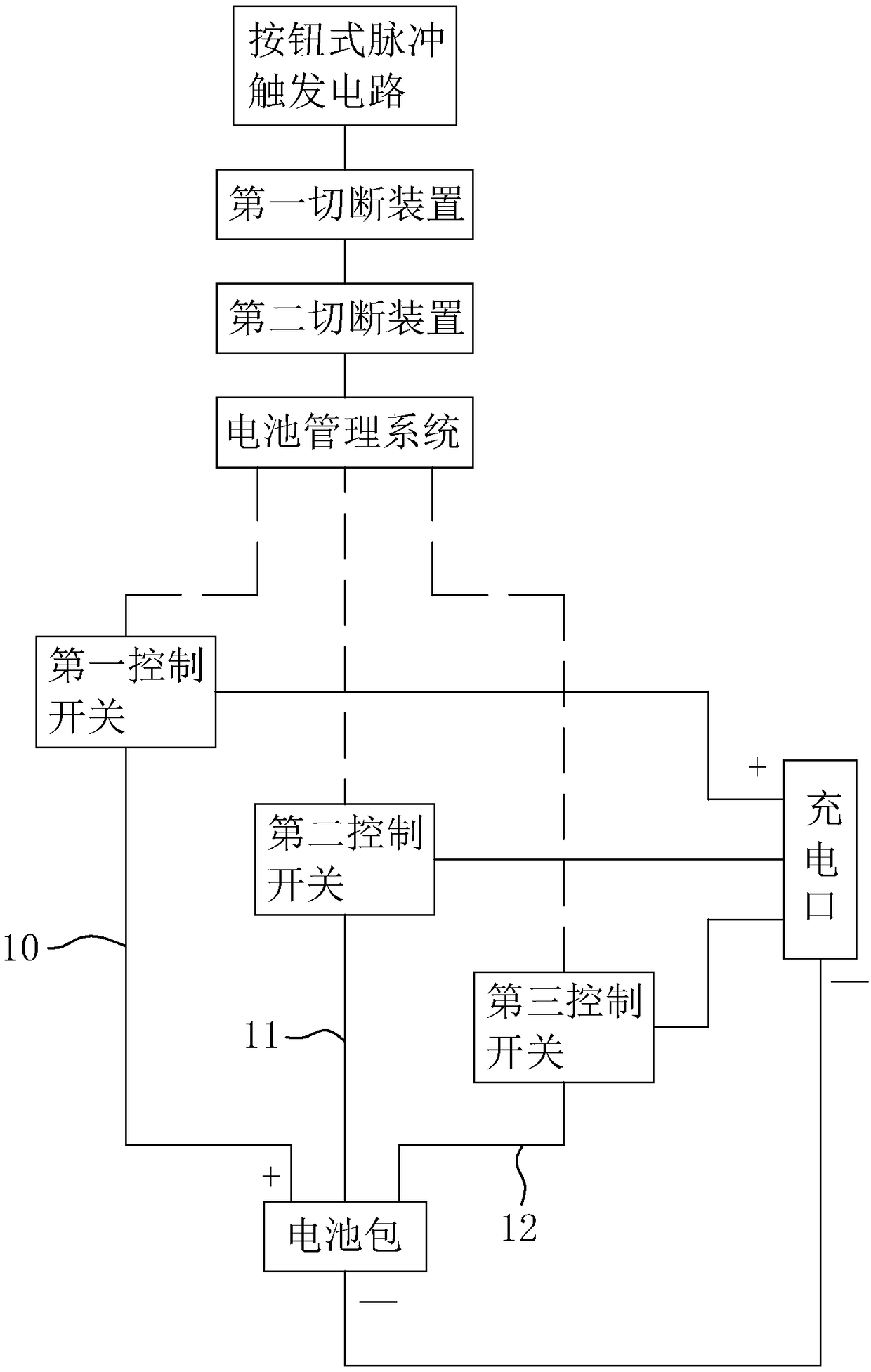Electric vehicle charging switching system and control method thereof
A technology for switching systems and electric vehicles, applied in electric vehicles, battery/fuel cell control devices, vehicle energy storage, etc., can solve problems such as large fast charging current, reduced battery life, and reduced battery charging efficiency
- Summary
- Abstract
- Description
- Claims
- Application Information
AI Technical Summary
Problems solved by technology
Method used
Image
Examples
Embodiment 1
[0062] Embodiment 1, a charging switching system for an electric vehicle disclosed in this embodiment includes a battery pack 1, a charging port 4, a trigger device, a battery management system 3, and a control switch, wherein the control switch includes a first control switch 5, a second The control switch 6 and the third control switch 7.
[0063] The positive pole of the charging port 4 and the positive pole of the battery pack 1 are arranged in parallel to form a first charging circuit 10, a second charging circuit 11 and a third charging circuit 12, and the negative pole thereof is coupled to the negative pole of the battery pack 1, that is, the battery pack 1 can Charge through the three charging circuits of the first charging circuit 10, the second charging circuit 11 and the third charging circuit 12 connected to the positive pole. The charging port 4 is used to connect to an external power supply, and the electric energy of the external power supply is charged to the b...
Embodiment 2
[0072] Embodiment 2, the trigger device further includes an overcurrent detection trigger circuit, which may preferably be an integrated overcurrent detection sensor chip.
[0073] The over-current detection trigger circuit is used to monitor the current change of the negative pole of the charging port 4 to output a corresponding over-current detection signal to the battery management system 3. When the battery pack 1 is in the process of normal charging, the current flowing through the negative pole of the charging port 4 The current is less than the standard current value.
[0074] Conversely, when the battery pack 1 is being charged, if an overcurrent phenomenon occurs in the first charging circuit 10, the second charging circuit 11 or the third charging circuit 12, the current flowing through the negative pole of the charging port 4 will be greater than the standard current value. At this time, the circuit with overcurrent fault in the first charging circuit 10, the secon...
Embodiment 3
[0077] Embodiment 3, on the basis of Embodiment 2, the overcurrent detection trigger circuit also has a reference value, which corresponds to the standard current value when the negative pole of the charging port 4 is working normally, and the standard current value is lower than the limit current value. When the battery pack 1 is in the process of fast charging, if there is a slight overcurrent phenomenon, that is, the current of the negative pole of the charging port 4 is higher than the standard current value but lower than the limit current value, the battery pack will not be damaged in a short time 1, but it is not suitable to keep the battery pack 1 in this state for a long time. If the first charging circuit 10, the second charging circuit 11 and the third charging circuit 12 are directly cut off at this time, although the overcurrent fault can be resolved in time, However, the battery pack 1 cannot continue to be charged, thereby affecting the charging efficiency.
[0...
PUM
 Login to View More
Login to View More Abstract
Description
Claims
Application Information
 Login to View More
Login to View More - R&D
- Intellectual Property
- Life Sciences
- Materials
- Tech Scout
- Unparalleled Data Quality
- Higher Quality Content
- 60% Fewer Hallucinations
Browse by: Latest US Patents, China's latest patents, Technical Efficacy Thesaurus, Application Domain, Technology Topic, Popular Technical Reports.
© 2025 PatSnap. All rights reserved.Legal|Privacy policy|Modern Slavery Act Transparency Statement|Sitemap|About US| Contact US: help@patsnap.com


